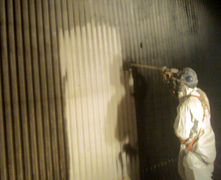Dry Ice Blasting is a Solution for Cleaning a Cogeneration Boiler
When it comes to maximizing resources and promoting energy efficiency in industrial settings, few technologies are as versatile and effective as cogeneration boilers. But in order to get the most out of these systems, you must understand how to properly clean them.
What is a Cogeneration Boiler?
Did you know that nearly two-thirds of all energy used by conventional methods of electricity generation is wasted through heat discharge into the atmosphere? Even more, energy is then wasted as electricity is distributed to end-users. But there is an alternative.
Also known as combined heat and power, or CHP, cogeneration refers to the simultaneous production of electricity and the recovery and utilization of the heat byproduct. It’s an efficient form of energy conversion that’s designed to achieve energy savings. When compared to the separate purchase of electricity from a typical electric grid, cogeneration can yield savings of nearly 40 percent.
Cogeneration systems are often used in combustion turbines and reciprocating engines. It’s also used in steam boilers with steam turbines.
CHP technology is used in more than 4,400 facilities nationwide. This includes a variety of commercial buildings (hotels, health clubs, and nursing homes), residential settings (condos and apartments), institutions, (colleges, hospitals, prisons, and military bases), municipal settings (wastewater treatments and district energy systems), and manufacturing facilities (including chemical, ethanol, refining, food processing, and glass manufacturing).
Precautions for Cleaning a Cogeneration Boiler
Cogeneration boilers are designed to provide onsite production of power and reduce energy costs. But for them to live up to this role, they have to be properly maintained and cleaned (which requires a degree of precision and sensitivity).
The biggest concerns with cleaning cogeneration systems are damage to the system and corrosion. Sandblasting, which is one commonly used method, is highly abrasive and can rough up the surface of the system. Likewise, harsh chemicals can compromise the integrity of the boiler. But there is one smart solution: dry ice blasting.

Benefits of Using Dry Ice Blasting for Cleaning Cogeneration Boilers
Dry ice blasting is the process of projecting tiny dry ice pellets through a nozzle towards the surface that is to be cleaned. When the dry ice hits the surface, a reaction occurs. This reaction transforms the frozen ice pellets into carbon dioxide gas, which causes the dirt and grime on the surface of the boiler to loosen and break off.
The top benefits of using dry ice blasting for cleaning a cogeneration boiler include:
- Non-abrasive. Unlike sandblasting and other common methods of cleaning, dry ice blasting is non-abrasive. By the time the ice pellets make contact with the cogeneration boiler, it’s turned into a harmless gas.
- Totally safe. Dry ice changes from solid to gas. This makes it perfectly safe for boilers, people, and the environment.
- There’s absolutely no residue or moisture left behind. This makes cleanup a breeze.
- Zero entrapment. Because dry ice pellets evaporate, there’s no risk of entrapment within the system. This makes it much safer than sandblasting and other alternatives.




